CHINESE CERAMICS AND PORCELAIN
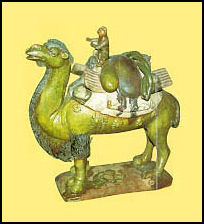
Tang Camel  The craft of making ceramics and clay vessels is one of the oldest human arts. Pottery is made by cooking soft clay at high temperatures until it hardens into an entirely new substance—ceramics. Early pottery vessels were used primarily for storing liquids, grains and other items. Clay pots were used for cooking and storage. Pottery from Japan dated to 10,000 B.C. is the oldest known in the world. Nine thousand year old sites in Turkey with ancient pottery have yielded mostly bowls and cups.
The craft of making ceramics and clay vessels is one of the oldest human arts. Pottery is made by cooking soft clay at high temperatures until it hardens into an entirely new substance—ceramics. Early pottery vessels were used primarily for storing liquids, grains and other items. Clay pots were used for cooking and storage. Pottery from Japan dated to 10,000 B.C. is the oldest known in the world. Nine thousand year old sites in Turkey with ancient pottery have yielded mostly bowls and cups.
 Potters first fired vessels in hearths, and afterwards in kilns. Kilns are special structures made of bricks or stones in which temperatures of at least 1,050°C can be generated. Firing ceramics at high temperatures improves their durability and impermeability and creates greater opportunities for changing the surface color.
Potters first fired vessels in hearths, and afterwards in kilns. Kilns are special structures made of bricks or stones in which temperatures of at least 1,050°C can be generated. Firing ceramics at high temperatures improves their durability and impermeability and creates greater opportunities for changing the surface color.
 The first pottery vessels were fashioned by hand from lumps of clay. The potter’s wheel was invented in Mesopotamia in 4000 B.C. With a potter’s wheel, a lump of clay can be spun around and round, shaped, usually into a vessel, with the hands and a variety of tools.
The first pottery vessels were fashioned by hand from lumps of clay. The potter’s wheel was invented in Mesopotamia in 4000 B.C. With a potter’s wheel, a lump of clay can be spun around and round, shaped, usually into a vessel, with the hands and a variety of tools.
 To make a pottery vessel, a potter must find the right clay, and purify and cure it to make it usable. Raw clays have traditionally been put into large vats to remove foreign matter such as sand and pebbles. When clay is washed these materials settle to the bottom while the clay remains suspended and is poured off. Clay washed in this manner is known as slip.
To make a pottery vessel, a potter must find the right clay, and purify and cure it to make it usable. Raw clays have traditionally been put into large vats to remove foreign matter such as sand and pebbles. When clay is washed these materials settle to the bottom while the clay remains suspended and is poured off. Clay washed in this manner is known as slip.
 Common ways of decorating pottery included printing selected areas, covering the surfaces with a thin slip made of iron-rich red clay, and burnishing (compacting the surface with a hard, tool such as a pebble).
Common ways of decorating pottery included printing selected areas, covering the surfaces with a thin slip made of iron-rich red clay, and burnishing (compacting the surface with a hard, tool such as a pebble).
Websites and Resources
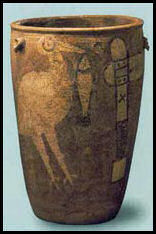
Yangshou vessel
3300 B.C. Good Websites and Sources: Pacific Asia Museum pacificasiamuseum.org ; Guide to Chinese Ceramics artsmia.org/art-of-asia ; Tang Horses China Vista ; Jingdezhen chinavista.com ;
Good Websites and Sources: Pacific Asia Museum pacificasiamuseum.org ; Guide to Chinese Ceramics artsmia.org/art-of-asia ; Tang Horses China Vista ; Jingdezhen chinavista.com ;
 Good Websites and Sources on Chinese Art: China --Art History Resources art-and-archaeology.com ; Art History Resources on the Web witcombe.sbc.edu ; Art of China Consortium nyu.edu/gsas/dept/fineart ;Modern Chinese Literature and Culture (MCLC) Visual Arts/mclc.osu.edu ; Asian Art.com asianart.com ; China Online Museum chinaonlinemuseum.com ; Huntington Archive of Asian Artkaladarshan.arts.ohio-state.edu ; Qing Art learn.columbia.edu Museums with First Rate Collections of Chinese Art National Palace Museum, Taipei npm.gov.tw ; Beijing Palace Museum dpm.org.cn ; Metropolitan Museum of Art metmuseum.org ; Sackler Museum in Washington asia.si.edu/collections ; China Page Museum list chinapage.com
Good Websites and Sources on Chinese Art: China --Art History Resources art-and-archaeology.com ; Art History Resources on the Web witcombe.sbc.edu ; Art of China Consortium nyu.edu/gsas/dept/fineart ;Modern Chinese Literature and Culture (MCLC) Visual Arts/mclc.osu.edu ; Asian Art.com asianart.com ; China Online Museum chinaonlinemuseum.com ; Huntington Archive of Asian Artkaladarshan.arts.ohio-state.edu ; Qing Art learn.columbia.edu Museums with First Rate Collections of Chinese Art National Palace Museum, Taipei npm.gov.tw ; Beijing Palace Museum dpm.org.cn ; Metropolitan Museum of Art metmuseum.org ; Sackler Museum in Washington asia.si.edu/collections ; China Page Museum list chinapage.com
 Chinese Culture: Cultural China (site with nice photos cultural-china.com ; China Culture.org chinaculture.org ; China Culture Online chinesecultureonline.com ;Chinatown Connection chinatownconnection.com ; Transnational China Culture Project ruf.rice.edu China Research Paper Search china-research-papers.com ; Book: The Culture and Civilization, a massive multi-volume series on Chinese culture (Yale University Press).
Chinese Culture: Cultural China (site with nice photos cultural-china.com ; China Culture.org chinaculture.org ; China Culture Online chinesecultureonline.com ;Chinatown Connection chinatownconnection.com ; Transnational China Culture Project ruf.rice.edu China Research Paper Search china-research-papers.com ; Book: The Culture and Civilization, a massive multi-volume series on Chinese culture (Yale University Press).
 Links in this Website: CHINA'S EARLIEST CULTURES Factsanddetails.com/China ; EARLY CHINESE ART Factsanddetails.com/China ; CHINESE ART FROM THE GREAT DYNASTIES Factsanddetails.com/China ; SHANG DYNASTY (2200-1700 B.C.) AND XIA DYNASTY Factsanddetails.com/China ; ZHOU (CHOU) DYNASTY (1100-221 B.C.) Factsanddetails.com/China ; HAN DYNASTY (206 B.C.-A.D. 220) Factsanddetails.com/China ; TANG DYNASTY (A.D. 690-907) Factsanddetails.com/China ; SONG DYNASTY (960-1279) Factsanddetails.com/China ;YUAN (MONGOL) DYNASTY (1215-1368) MING DYNASTY (1368-1644) Factsanddetails.com/China ; QING (MANCHU) DYNASTY (1644-1911) Factsanddetails.com/China ; CHINESE JADE Factsanddetails.com/China ; CHINESE CERAMICS AND PORCELAIN Factsanddetails.com/China ; CHINESE PAINTING Factsanddetails.com/China ;CHINESE CALLIGRAPHY Factsanddetails.com/China ; CHINESE CRAFTS Factsanddetails.com/China ; COLLECTING, LOOTING AND COPYING ART IN CHINA Factsanddetails.com/China
Links in this Website: CHINA'S EARLIEST CULTURES Factsanddetails.com/China ; EARLY CHINESE ART Factsanddetails.com/China ; CHINESE ART FROM THE GREAT DYNASTIES Factsanddetails.com/China ; SHANG DYNASTY (2200-1700 B.C.) AND XIA DYNASTY Factsanddetails.com/China ; ZHOU (CHOU) DYNASTY (1100-221 B.C.) Factsanddetails.com/China ; HAN DYNASTY (206 B.C.-A.D. 220) Factsanddetails.com/China ; TANG DYNASTY (A.D. 690-907) Factsanddetails.com/China ; SONG DYNASTY (960-1279) Factsanddetails.com/China ;YUAN (MONGOL) DYNASTY (1215-1368) MING DYNASTY (1368-1644) Factsanddetails.com/China ; QING (MANCHU) DYNASTY (1644-1911) Factsanddetails.com/China ; CHINESE JADE Factsanddetails.com/China ; CHINESE CERAMICS AND PORCELAIN Factsanddetails.com/China ; CHINESE PAINTING Factsanddetails.com/China ;CHINESE CALLIGRAPHY Factsanddetails.com/China ; CHINESE CRAFTS Factsanddetails.com/China ; COLLECTING, LOOTING AND COPYING ART IN CHINA Factsanddetails.com/China
Early Pottery in China
 The earliest examples of clay pottery found in China date back to 6000 B.C. These clay vessels—some of them with painted flowers, fish, human faces, vaginas and geometric designs—were created by the "Yangshao Culture," (named after village near the confluence of the Yellow, Fen and Wei rivers where the artifacts were found).
The earliest examples of clay pottery found in China date back to 6000 B.C. These clay vessels—some of them with painted flowers, fish, human faces, vaginas and geometric designs—were created by the "Yangshao Culture," (named after village near the confluence of the Yellow, Fen and Wei rivers where the artifacts were found).
 Beginning around 3500 B.C., the Lungshnanoid Culture (named after a village in Shandong province where the artifacts were found) produced white pottery and "eggshell-thin" black pottery. Multi-colored and burnished black pottery appeared in Neolithic times in settlements along the upper, middle and lower reaches of the Yellow and Yangtze River.
Beginning around 3500 B.C., the Lungshnanoid Culture (named after a village in Shandong province where the artifacts were found) produced white pottery and "eggshell-thin" black pottery. Multi-colored and burnished black pottery appeared in Neolithic times in settlements along the upper, middle and lower reaches of the Yellow and Yangtze River.
 Advancement in firing techniques lead to new types of pottery such as high-fired stoneware and glazed stoneware developed during the Shang (1766-1122 B.C.), Zhou (1122-221 B.C.), Qin (221-206 B.C.) and Han (206 B.C.— A.D. 220) dynasties.
Advancement in firing techniques lead to new types of pottery such as high-fired stoneware and glazed stoneware developed during the Shang (1766-1122 B.C.), Zhou (1122-221 B.C.), Qin (221-206 B.C.) and Han (206 B.C.— A.D. 220) dynasties.
Ancient Chinese Ceramics
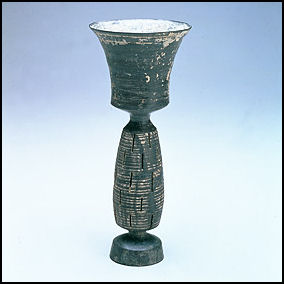
Cermaic black pottery cup,
Liungshan Culture 2600 2000 B.C.  Chinese ceramics is famous for its exquisite forms, shapes, finishes and delicate use of color. Early in China’s history it was raised above utilitarianism to a fine art. Great works of art were patronized by the imperial court and the upper classes and sought after outside of China in Europe and other places.
Chinese ceramics is famous for its exquisite forms, shapes, finishes and delicate use of color. Early in China’s history it was raised above utilitarianism to a fine art. Great works of art were patronized by the imperial court and the upper classes and sought after outside of China in Europe and other places.
 A fine white pottery was made during the Shang Dynasty. Many vessels were similar in size and shape to bronze vessels made during the same period. Scholars believe the bronze vessels were likely copies of ceramic vessels.
A fine white pottery was made during the Shang Dynasty. Many vessels were similar in size and shape to bronze vessels made during the same period. Scholars believe the bronze vessels were likely copies of ceramic vessels.
 Many great works of pottery and ceramic art came from the Han Dynasty (206 B.C.— A.D. 220). Lovely vessels and objects were buried with dead and have been excavated by archeologists and looters. The first use of glazes on Chinese pottery dates back to this period. Beautiful figures, particularly of animals, were created during Six Dynasties period (A.D. 220-587).
Many great works of pottery and ceramic art came from the Han Dynasty (206 B.C.— A.D. 220). Lovely vessels and objects were buried with dead and have been excavated by archeologists and looters. The first use of glazes on Chinese pottery dates back to this period. Beautiful figures, particularly of animals, were created during Six Dynasties period (A.D. 220-587).
Tang Horses

 Tang horses are among the most famous works of Chinese art. Made from ceramic, some are glazed in blue, green amber and have elaborate saddle blankets and tasseled bridles. Other are made of unglazed ceramic and thereby look more modern like a Rodin statute. The horses are often in frantic positions: with their heads raises and nostrils flared, or twisting around to get at something on their backs. Many had a grooved channel running the length of the arched neck, where a real horsehair mane was placed, and had a hole in their rear for a horsehair tail. Most are only around 15 inches tall.
Tang horses are among the most famous works of Chinese art. Made from ceramic, some are glazed in blue, green amber and have elaborate saddle blankets and tasseled bridles. Other are made of unglazed ceramic and thereby look more modern like a Rodin statute. The horses are often in frantic positions: with their heads raises and nostrils flared, or twisting around to get at something on their backs. Many had a grooved channel running the length of the arched neck, where a real horsehair mane was placed, and had a hole in their rear for a horsehair tail. Most are only around 15 inches tall.
 Chinese art specialist J.J. Lally told the New York Times, "Tang horses are the most widely popular image of Chinese art because they are immediately accessible to everyone. You don't have to read the Tang dynasty was a moment in Chinese art when there was a strong move toward realism and strong decorative impulse. Horses imported from the Near East were precious. In Tang China, the horse was the emblem of wealth and power. They are meant to embody rank and speed."
Chinese art specialist J.J. Lally told the New York Times, "Tang horses are the most widely popular image of Chinese art because they are immediately accessible to everyone. You don't have to read the Tang dynasty was a moment in Chinese art when there was a strong move toward realism and strong decorative impulse. Horses imported from the Near East were precious. In Tang China, the horse was the emblem of wealth and power. They are meant to embody rank and speed."
 The Chinese used horses as far back as the Shang dynasty (1600 to 1100 B.C.) but these were mainly strong, draft animals. Later they began importing horses from Central Asia and Middle East. By the Tang dynasty horses were favorite subjects of not only artists but also poets and composers. The inspiration for the many of Tang horses were Tall horses, the heavenly horses from Central Asia introduced to China in the first century B.C.
The Chinese used horses as far back as the Shang dynasty (1600 to 1100 B.C.) but these were mainly strong, draft animals. Later they began importing horses from Central Asia and Middle East. By the Tang dynasty horses were favorite subjects of not only artists but also poets and composers. The inspiration for the many of Tang horses were Tall horses, the heavenly horses from Central Asia introduced to China in the first century B.C.
Varieties of Tang Horses
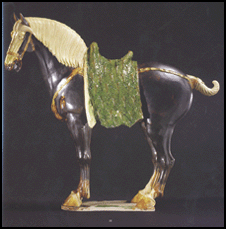
 Some of the most treasured Tang horses were glazed in cobalt blue. Gallery owner Khalil Rizk told the New York Times, "Only 5 percent of Tang horses have blue glaze. Cobalt was put on during the last firing. Cobalt was a treasured commodity imported from the Middle East; it was more valuable than gold. Its use means the horse was for someone of the highest rank.”
Some of the most treasured Tang horses were glazed in cobalt blue. Gallery owner Khalil Rizk told the New York Times, "Only 5 percent of Tang horses have blue glaze. Cobalt was put on during the last firing. Cobalt was a treasured commodity imported from the Middle East; it was more valuable than gold. Its use means the horse was for someone of the highest rank.”
 Describing a relatively ordinary Tang horse that sold for $266,500 at a Christie's auction, Wendy Moonan wrote in the New York Times, "Unglazed, it had its head lowered toward its left foreleg, which was slightly raised.”
Describing a relatively ordinary Tang horse that sold for $266,500 at a Christie's auction, Wendy Moonan wrote in the New York Times, "Unglazed, it had its head lowered toward its left foreleg, which was slightly raised.”
 One extraordinary glazed Tang pieces depicts a kneeling man with a horse's head. The expression on the horse's head is sensitive. Tang artist also made some extraordinarily beautiful ceramic animals, including a glazed earthenware camel carrying a troupe of musicians.
One extraordinary glazed Tang pieces depicts a kneeling man with a horse's head. The expression on the horse's head is sensitive. Tang artist also made some extraordinarily beautiful ceramic animals, including a glazed earthenware camel carrying a troupe of musicians.
 The highest price ever paid for ceramics and/or a Chinese work of art was $6.1 million for a Tang dynasty horse sold by the British Rail Pension Fund to a Japanese dealer at Sotheby's in London in December 1989. Collectors like Tang horses because they can be dated with some certainty using thermoluminescnece testing.
The highest price ever paid for ceramics and/or a Chinese work of art was $6.1 million for a Tang dynasty horse sold by the British Rail Pension Fund to a Japanese dealer at Sotheby's in London in December 1989. Collectors like Tang horses because they can be dated with some certainty using thermoluminescnece testing.
Porcelain in China
 Porcelain is a type of pottery made from kaolin, a fine whitish clay composed of quartz and feldspar, that becomes hard, glossy and nearly transparent when it is fired in a kiln. The word "porcelain" reportedly is derived from the Italian word porcella, meaning little pig, or possibly from a similar word meaning female pig genitals. The name was given first to a smooth, white, cowrie shell, and then to the smooth, white finish on porcelain pottery. The term “porcelain” was used in Marco Polo’s writings. Porcelain pieces can be dated by their inscribed reign marks.
Porcelain is a type of pottery made from kaolin, a fine whitish clay composed of quartz and feldspar, that becomes hard, glossy and nearly transparent when it is fired in a kiln. The word "porcelain" reportedly is derived from the Italian word porcella, meaning little pig, or possibly from a similar word meaning female pig genitals. The name was given first to a smooth, white, cowrie shell, and then to the smooth, white finish on porcelain pottery. The term “porcelain” was used in Marco Polo’s writings. Porcelain pieces can be dated by their inscribed reign marks.
 True porcelain is made of fine kaolin clay and feldspar, also known as petuntse or Chinese stone. It is white, thin and transparent or translucent. Before it is shaped the kaolin is mixed, filtered and vacuum pressed into slabs for aging.
True porcelain is made of fine kaolin clay and feldspar, also known as petuntse or Chinese stone. It is white, thin and transparent or translucent. Before it is shaped the kaolin is mixed, filtered and vacuum pressed into slabs for aging.
 Blue and white porcelain has traditionally been made from kaolin clay mined near Jingdezhen, a town in southern China, and mixed with a particular kind of cobalt imported from Persia. Other kinds of porcelain include underglaze red, underglaze blue, copper red (used for imperial ceremonies), "sweet-white," peacock blue and celadon green.
Blue and white porcelain has traditionally been made from kaolin clay mined near Jingdezhen, a town in southern China, and mixed with a particular kind of cobalt imported from Persia. Other kinds of porcelain include underglaze red, underglaze blue, copper red (used for imperial ceremonies), "sweet-white," peacock blue and celadon green.
History of Porcelain in China

Tang celadon  The Chinese made the earliest known porcelain around A.D. 700 and held a global monopoly on its production for over a thousand years. Chinese porcelain didn't reach Europe until the 14th century and the art of making porcelain wasn’t developed in Japan until the 16th century and in in Europe until the 17th century.
The Chinese made the earliest known porcelain around A.D. 700 and held a global monopoly on its production for over a thousand years. Chinese porcelain didn't reach Europe until the 14th century and the art of making porcelain wasn’t developed in Japan until the 16th century and in in Europe until the 17th century.
 Porcelain evolved step-by-step from 5,000-year-old painted pottery through a process of refining materials and manufacturing. A greenish glaze applied to stoneware was developed in the early Han (206 B.C. to A.D. 220) dynasty. A glaze that resembled the sort used on porcelain was made in the early Sui dynasty.
Porcelain evolved step-by-step from 5,000-year-old painted pottery through a process of refining materials and manufacturing. A greenish glaze applied to stoneware was developed in the early Han (206 B.C. to A.D. 220) dynasty. A glaze that resembled the sort used on porcelain was made in the early Sui dynasty.
 Celadons evolved during the Six Dynasties period (A.D. 220-589). It is green porcelain made with a slip and glaze, sometimes with incised and inlaid decorations. It is associated with both China and Korea.
Celadons evolved during the Six Dynasties period (A.D. 220-589). It is green porcelain made with a slip and glaze, sometimes with incised and inlaid decorations. It is associated with both China and Korea.
 Proto-porcelain evolved during the Tang dynasty. It was made by mixing clay with quartz and the mineral feldspar to make a hard, smooth-surfaced vessel. Feldspar was mixed with small amounts of iron to produce an olive-green glaze.
Proto-porcelain evolved during the Tang dynasty. It was made by mixing clay with quartz and the mineral feldspar to make a hard, smooth-surfaced vessel. Feldspar was mixed with small amounts of iron to produce an olive-green glaze.
 In China, porcelain was produced to be enjoyed on three levels: aesthetic, technical and symbolic. The ways the painted subject on porcelain interact often portrayed a meaning beyond the symbols. A five-claws dragon superimposed on tangerines and pomegranates, for example, links the royal family with fertility (pomegranates) and prosperity (tangerines).
In China, porcelain was produced to be enjoyed on three levels: aesthetic, technical and symbolic. The ways the painted subject on porcelain interact often portrayed a meaning beyond the symbols. A five-claws dragon superimposed on tangerines and pomegranates, for example, links the royal family with fertility (pomegranates) and prosperity (tangerines).
Song Dynasty Porcelain
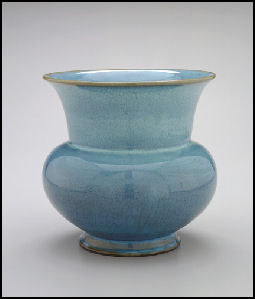
 Some of the most beautiful porcelain ever produced was made during the Song dynasty (960-1279), when world-famous monochrome porcelains, including celedon, were produced. Celadon is green porcelain made with a slip and glaze, sometimes with incised and inlaid decorations. It is associated with both China and Korea.
Some of the most beautiful porcelain ever produced was made during the Song dynasty (960-1279), when world-famous monochrome porcelains, including celedon, were produced. Celadon is green porcelain made with a slip and glaze, sometimes with incised and inlaid decorations. It is associated with both China and Korea.
 Wonderful crazed or cracked glazed pottery, produced by the shrinking and cracking of the glazes due to rapid cooling, appeared during the Song period. The earliest pieces with this kind of glazing were probably made by accident in the firing process but later was developed into an art form that had a great impact outside of China, influencing the famous tea ceremony ceramics of Japan.
Wonderful crazed or cracked glazed pottery, produced by the shrinking and cracking of the glazes due to rapid cooling, appeared during the Song period. The earliest pieces with this kind of glazing were probably made by accident in the firing process but later was developed into an art form that had a great impact outside of China, influencing the famous tea ceremony ceramics of Japan.
 Ching-te Chen in the Chiang-shsi province (present-day Jiangdezhen in Jiangxi Province) became the seat of imperial ceramic making under Emperor Chen Tsung around A.D. 1000. Porcelain from the imperial plant here was regarded as the best and was reserved for imperial use.
Ching-te Chen in the Chiang-shsi province (present-day Jiangdezhen in Jiangxi Province) became the seat of imperial ceramic making under Emperor Chen Tsung around A.D. 1000. Porcelain from the imperial plant here was regarded as the best and was reserved for imperial use.
 Ju ware, a kind of celadon from the Northern Song dynasty that ranges in color from blue to green, is the rarest of all forms of porcelain. Only 65 pieces of it exist and 23 of them are possessed by the National Palace Museum in Taipei.
Ju ware, a kind of celadon from the Northern Song dynasty that ranges in color from blue to green, is the rarest of all forms of porcelain. Only 65 pieces of it exist and 23 of them are possessed by the National Palace Museum in Taipei.
Yuan Porcelain
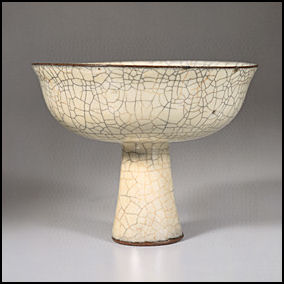
 In the Yuan Dynasty (1279-1368) floral motifs and cobalt blue paintings were made under a porcelain glaze. This was considered the last great advancement of Chinese ceramics. The cobalt used to make designs on white porcelain was introduced by Muslim traders in the 15th century.
In the Yuan Dynasty (1279-1368) floral motifs and cobalt blue paintings were made under a porcelain glaze. This was considered the last great advancement of Chinese ceramics. The cobalt used to make designs on white porcelain was introduced by Muslim traders in the 15th century.
 The blue-and-white and polychrome wares from the Yuan Dynasty were not as delicate as the porcelain produced in the Song dynasty. Multi-colored porcelain with floral designs was produced in the Yuan dynasty and perfected in the Qing dynasty, when new colors and designs were introduced.
The blue-and-white and polychrome wares from the Yuan Dynasty were not as delicate as the porcelain produced in the Song dynasty. Multi-colored porcelain with floral designs was produced in the Yuan dynasty and perfected in the Qing dynasty, when new colors and designs were introduced.
 The world record price paid for an art work from any Asian culture is $27.8 million, paid in March 2005 for a 14th century Chinese porcelain vessel with blue designs painted on a white background. The vessel contains scenes of historical events in the 6th century B.C. and has unique Persian-influenced shape. Only seven jars of this shape exist in the world. The buyer was Giuseppe Eskenazi., the renowned dealer of Chinese art, acting on behalf of a client. The previous record for porcelain was $5.83 million paid for a14th-century blue-and-white porcelain vessel called the pilgrims vessel in September 2003.
The world record price paid for an art work from any Asian culture is $27.8 million, paid in March 2005 for a 14th century Chinese porcelain vessel with blue designs painted on a white background. The vessel contains scenes of historical events in the 6th century B.C. and has unique Persian-influenced shape. Only seven jars of this shape exist in the world. The buyer was Giuseppe Eskenazi., the renowned dealer of Chinese art, acting on behalf of a client. The previous record for porcelain was $5.83 million paid for a14th-century blue-and-white porcelain vessel called the pilgrims vessel in September 2003.
Ming Porcelain
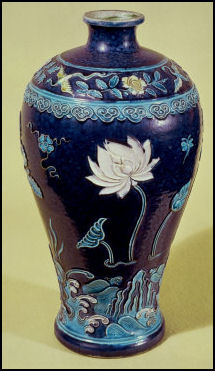
 Ming Dynasty (1368-1644) ceramics were known for the boldness of their form and decoration and the varieties of design. Craftsmen made both huge and highly decorated vessels and small, delicate, white ones. Many of the wonderful decorations and glazes—peach bloom, moonlight blue, cracked ice, and ox blood glazes; and rice grain, rose pink and black decorations—were inspired by nature.
Ming Dynasty (1368-1644) ceramics were known for the boldness of their form and decoration and the varieties of design. Craftsmen made both huge and highly decorated vessels and small, delicate, white ones. Many of the wonderful decorations and glazes—peach bloom, moonlight blue, cracked ice, and ox blood glazes; and rice grain, rose pink and black decorations—were inspired by nature.
 In 1402, the Ming Emperor Jianwen ordered the establishment of an imperial porcelain factory in Jingdezhen. It's sole function was to produce porcelain for court use in state and religious ceremonies and for tableware and gifts.
In 1402, the Ming Emperor Jianwen ordered the establishment of an imperial porcelain factory in Jingdezhen. It's sole function was to produce porcelain for court use in state and religious ceremonies and for tableware and gifts.
 Between 1350 and 1750 Jiangdezhen was the production center for nearly all of the world's porcelain. Jiangdezhen was located near abundant supplies of kaolin, the clay used in porcelain making, and fuel needed to fire up kilns. It also had access to China's coast, which was used for transporting finished products to places in China and around the world. So much porcelain was made that Jingdezhen now sits on a foundation of shards from discarded pottery that over is four meters deep in places.
Between 1350 and 1750 Jiangdezhen was the production center for nearly all of the world's porcelain. Jiangdezhen was located near abundant supplies of kaolin, the clay used in porcelain making, and fuel needed to fire up kilns. It also had access to China's coast, which was used for transporting finished products to places in China and around the world. So much porcelain was made that Jingdezhen now sits on a foundation of shards from discarded pottery that over is four meters deep in places.
Ming Porcelain Exports
 From the beginning production at the Ming porcelain factories in Jingdezhen were oriented towards the export market. The factories produced coffee cups and beer mugs centuries before these drinks became popular in China. They also produced plates with Arabic and Persian motifs and place setting emblazoned with European coats of arms.
From the beginning production at the Ming porcelain factories in Jingdezhen were oriented towards the export market. The factories produced coffee cups and beer mugs centuries before these drinks became popular in China. They also produced plates with Arabic and Persian motifs and place setting emblazoned with European coats of arms.
 The porcelain trade was so lucrative that the porcelain making processes were closely guarded secrets and Jingdezhen was officially off limits to visitors to keep spies from uncovering these secrets. Over three million pieces were exported to Europe between 1604 and 1657 alone. This was around that the same time that the word "china" began being used in England to describe porcelains because the two were so closely associated with each other.
The porcelain trade was so lucrative that the porcelain making processes were closely guarded secrets and Jingdezhen was officially off limits to visitors to keep spies from uncovering these secrets. Over three million pieces were exported to Europe between 1604 and 1657 alone. This was around that the same time that the word "china" began being used in England to describe porcelains because the two were so closely associated with each other.
 Pere d’Entrecolles, a Jesuit missionary from France, secretly entered Jingdezhen and described porcelain making in the city in letters that made their way to Europe in the early 1700s. He described a city with a million people and 3,000 kilns that were fired up day and night and filled the night sky with an orange glow. He learned the process but confused the clays.
Pere d’Entrecolles, a Jesuit missionary from France, secretly entered Jingdezhen and described porcelain making in the city in letters that made their way to Europe in the early 1700s. He described a city with a million people and 3,000 kilns that were fired up day and night and filled the night sky with an orange glow. He learned the process but confused the clays.
 Around he same time that d’Entrecolles was describing porcelain-making in Jingdezhen, Germans working independently in their homeland discovered the secret to making porcelain Large scale porcelain production began in the West in 1710 in Meissen, Germany.
Around he same time that d’Entrecolles was describing porcelain-making in Jingdezhen, Germans working independently in their homeland discovered the secret to making porcelain Large scale porcelain production began in the West in 1710 in Meissen, Germany.
 Chinese porcelain dominated the world until European manufacturers such as those in Messen, Germany and Wedgewood, England began producing products of equal quality but at a cheaper price. After that the Chinese porcelain industry collapsed as many industries have done today when underpriced by cheap Chinese imports.
Chinese porcelain dominated the world until European manufacturers such as those in Messen, Germany and Wedgewood, England began producing products of equal quality but at a cheaper price. After that the Chinese porcelain industry collapsed as many industries have done today when underpriced by cheap Chinese imports.
Qing Porcelain
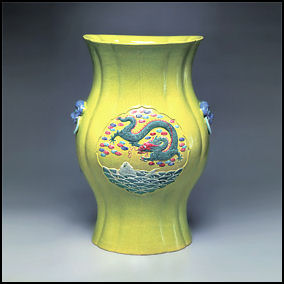
 Qing dynasty (1644-1912) porcelain was famous for its polychrome decorations, delicately painted landscapes, and bird and flower and multicolored enamel designs. Many of the subject had symbolic meanings. The work of craftsmen reached a high point during the reign of Emperor Kangxi (1662-1722)
Qing dynasty (1644-1912) porcelain was famous for its polychrome decorations, delicately painted landscapes, and bird and flower and multicolored enamel designs. Many of the subject had symbolic meanings. The work of craftsmen reached a high point during the reign of Emperor Kangxi (1662-1722)
 During a rebellion in 1853, the imperial factory was burned. Rebels sacked the town and killed some potters. The factory was rebuilt in 1864 but never regained its former stature. With the end of the Qing dynasty in 1912, the long history of Chinese porcelain making drew to a close.
During a rebellion in 1853, the imperial factory was burned. Rebels sacked the town and killed some potters. The factory was rebuilt in 1864 but never regained its former stature. With the end of the Qing dynasty in 1912, the long history of Chinese porcelain making drew to a close.
No comments:
Post a Comment